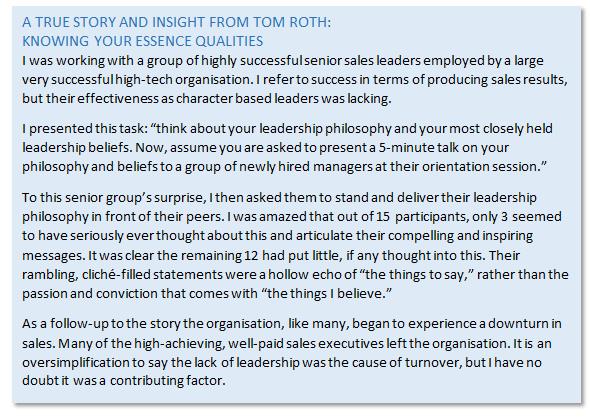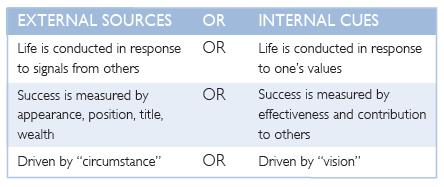There is a collective sigh from leaders for the first time in recent history as the slow tide of economic recovery washes in. For some, the sigh may be more or less audible. Nevertheless, leaders are moving away from expending energy on preventing failure or avoiding crisis and shifting their energy toward creating new growth opportunities and seeking fresh success strategies.
 This energy shift won’t happen automatically; rather, leaders must make a conscious, intentional shift. Leaders play a key role in harnessing the energy of their followers to ride this new wave of economic recovery - regardless of the size of the surf.
This energy shift won’t happen automatically; rather, leaders must make a conscious, intentional shift. Leaders play a key role in harnessing the energy of their followers to ride this new wave of economic recovery - regardless of the size of the surf.
The leader’s purpose
“Ultimately you will not be judged so much by how well you lead, but by how well you are followed.”
The purpose of a leader is to engage others to commit their full energy toward the creation of value and success. Followers show up every day with energy, be it positive, negative, or somewhere in between. They choose the degree to which they give their energy to their job, customers and co-workers. Key to leadership is engaging followers to choose to commit their full energy.
Consider the statistic that, on average, (a whopping) 69% of employee satisfaction and performance is attributable to the action of the work unit leader.1 Leaders play a unique role with each one of their followers, and it can be a powerful one that ultimately erodes or contributes to the creation of value and success for the organisation, its customers, the work team, and leaders themselves.
So how do leaders best contribute to, not erode, the creation of value and success?
Character based leadership
Character-based (or essence) leadership refers to what is at the core; those qualities of a leader that are driven from the inside out. Essence is about purpose, values, beliefs, and vision. It is who the leader wants to BE to their followers - the example the leader wants to set.
Form refers to what a leader DOES - behaviours and actions taken that demonstrate leadership competencies and often are driven by organisational rules and policies. Form comes from the outside in. It is the image or persona the leader creates.
While both essence and form are important, they need to be in balance. Often, if there is no integration between essence and form, a credibility gap appears and trust becomes an issue. Integrity is the integration between who one is and what one does - essence and form.
This idea of essence and form opens a dialog with leaders - such as the true story cited below - to discover, define, and declare their leadership.
 Based on a leadership foundation of declared philosophy, purpose, values, beliefs, strengths, and vision, character-based leadership requires an intentional shift in setting an example from the inside out. And that takes a large dose of both resiliency and courage. Let’s explore these notions further.
Based on a leadership foundation of declared philosophy, purpose, values, beliefs, strengths, and vision, character-based leadership requires an intentional shift in setting an example from the inside out. And that takes a large dose of both resiliency and courage. Let’s explore these notions further.
Resiliancy - pathfinding and stewardship
What comes to mind when you think of fabric that is resilient? Something that is flexible yet durable? Elastic yet tough? Similarly, a resilient leader needs to strike a balance between being flexible and durable; in other words, between pathfinding and stewardship.
As Pathfinders, leaders are expected to continually change or renew that part of the organisation for which they are responsible, working on ways to make things better, more effective, or different. Pathfinding calls for taking followers to a place they would not go by themselves.
On the other hand, in volatile, fast-paced times, people yearn for some form of constancy. They won’t find it in the marketplace; they won’t find it in most organisations. So where should they look for it?
The answer: They should look to the leader. As Stewards, leaders are expected to protect constants - what doesn’t change. In the midst of organisational and marketplace change, employees will want to see a set of enduring tenets that do not change. These tenets include a leader’s philosophy, purpose, deep values, strengths, and vision. These are a leader’s essence qualities - the example the leader wants to set.
These two roles may seem paradoxical, but they really aren’t. The path is 'how' you get there; this can and will constantly change. But 'who' you are and what you stand for stays the same. If you believe in it, you stand by that.
Where do you get the courage to lead?
“Unless we stand for something, we shall fall for anything.” - Peter Marshall, U. S. Senate chaplain, April 18, 1947
The Oxford American Dictionary defines courage as “the conviction to act on one’s beliefs”. Leadership requires acting in a courageous manner on matters that are not always easy or popular.
What allows you to be courageous? Being clear on what you stand for - your values, beliefs, etc.; what we have referred to as essence qualities.
Ask yourself: Do my leadership signals come from outside - from external sources? Or do they come from within - from internal cues?

If you get signals from external sources, then you tend to waver in the wind, and are subject to doing things to meet others’ approval - which is always subject to change.
Taking leadership action based on external sources suggests that in order to get people to follow you, you must get them to like and approve of you. But the reality is that people tend to follow leaders who are true to what they believe in and act consistently on their beliefs, even when their actions may not be popular. These are the resilient, courageous leaders.
If the people who call you their leader were asked, what would they say about you that causes them to commit their energy and follow you?
1 “Redefining Employee Satisfaction: Business Performance, Employee Fulfillment, and Leadership Practices,” Wilson Learning.